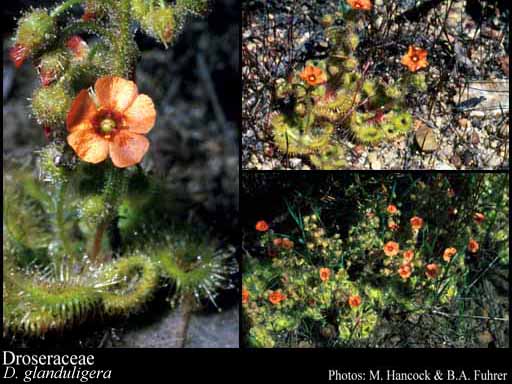- Reference
- Parad.Lond. pt.95 (1808)
- Name Status
- Current







Scientific Description
Common name. Sundew Family.
Habit and leaf form. Herbs (to subshrubs). Plants with roots, or rootless (Aldrovanda); ‘carnivorous’. Trapping mechanism active. The traps constituted by sticky leaf glands, associated with subsequent, slow enclosure of the prey by movement of the blade (Drosera, Drosophyllum), or consisting of the curiously modified, steel-trap-like leaf blades, which spring shut when adaxial receptors are touched (Aldrovanda, Dionaea). Plants with a basal concentration of leaves (often), or with neither basal nor terminal concentrations of leaves; rhizomatous, or tuberous. Hydrophytic (Aldrovanda), or helophytic to mesophytic (usually in acid bogs); sometimes free floating (Aldrovanda). Leaves of Aldrovanda submerged; small to medium-sized; alternate (usually), or whorled (Aldrovanda); spiral, or four-ranked; petiolate; non-sheathing; simple. Leaf blades entire. Leaves with stipules, or without stipules; without a persistent basal meristem. Vernation often circinnate; often circinnate. Stem anatomy. Secondary thickening absent.
Reproductive type, pollination. Fertile flowers hermaphrodite. Unisexual flowers absent. Plants hermaphrodite. Entomophilous.
Inflorescence and flower features. Flowers solitary, or aggregated in ‘inflorescences’; in cymes. The terminal inflorescence unit cymose (usually), or racemose (rarely). Inflorescences usually cincinni. Flowers regular; usually 4–5 merous; cyclic; tetracyclic, or pentacyclic. Free hypanthium present (slight), or absent. Hypogynous disk absent. Perianth with distinct calyx and corolla; 8–10(–16); 2 -whorled; isomerous. Calyx 4–5(–8); 1 -whorled; scarcely gamosepalous, or polysepalous; imbricate; regular; persistent (marcescent). Corolla 4–5(–8); 1 -whorled; polypetalous; imbricate, or contorted; regular. Petals shortly clawed. Androecium (4–)5 (usually), or 10–20 (rarely). Androecial members branched, or unbranched; free of the perianth; all equal; free of one another, or coherent; when cohering 1 - adelphous (basally connate in Dionaea); 1 -whorled, or 2 -whorled. Androecium exclusively of fertile stamens. Stamens (4–)5, or (10–)20; isomerous with the perianth to triplostemonous. Anthers dorsifixed, or basifixed; dehiscing via longitudinal slits; extrorse; tetrasporangiate. Pollen shed in aggregates, or shed as single grains (Drosophyllum); usually in tetrads. Gynoecium 3(–5) carpelled. The pistil 1 celled. Gynoecium syncarpous; synovarious, or synstylovarious; superior. Ovary unilocular; 1 locular. The ‘odd’ carpel when G3 posterior. Gynoecium stylate. Styles 1, or 3(–5); free, or partially joined; apical. Stigmas often 2 - lobed; dry type; papillate; Group II type. Placentation parietal, or basal. Ovules in the single cavity 3–100 (i.e. to ‘many’); ascending; non-arillate; anatropous.
Fruit and seed features. Fruit non-fleshy; dehiscent (nearly always), or indehiscent (Aldrovanda); a capsule (nearly always), or capsular-indehiscent (Aldrovanda). Capsules loculicidal, or valvular. Seeds copiously endospermic. Endosperm oily. Seeds with starch. Embryo well differentiated (small). Cotyledons 2. Embryo straight. Seedling. Germination phanerocotylar, or cryptocotylar.
Physiology, biochemistry. Aluminium accumulation not found. Photosynthetic pathway: C3.
Geography, cytology, number of species. World distribution: widespread. X = 6–17(+). 105 species.
Keys
Western Australian Genera and Families of Flowering Plants — an interactive key
T.D. Macfarlane, L. Watson, N.G. Marchant